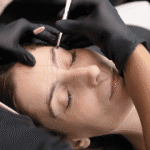Melasma, characterized by dark patches on the skin, is a common condition. It can significantly affect one’s confidence and quality of life. Melasma predominantly appears on the face, especially on the cheeks, forehead, and upper lip. It is more common in women, particularly those with darker skin tones. Understanding melasma and exploring effective treatments, such as laser therapy, can provide hope for managing this persistent skin condition.
Understanding Melasma
Melasma is a form of hyperpigmentation. It occurs when the skin produces too much melanin, the pigment responsible for skin color. Several factors contribute to melasma, including genetic predisposition, hormonal changes (like pregnancy or birth control use), and sun exposure. UV radiation from the sun often exacerbates existing melasma, making it harder to treat.
Melasma patches vary in appearance, ranging from light brown to dark brown or even grayish. These patches are usually symmetrical and can be found on both sides of the face. Although melasma is harmless and not physically painful, its cosmetic impact can lead to emotional distress and lower self-esteem.
Laser Treatments Explained
Laser treatments are a promising option for reducing melasma’s appearance. Various types of lasers, including fractional lasers, Q-switched lasers, and Pico lasers, target hyperpigmented areas in dermatological practices.
Fractional Lasers: These lasers create micro-injuries in the skin, stimulating the body’s natural healing process and promoting healthy skin cell regeneration. Fractional lasers can penetrate deeply, making them effective for severe melasma cases.
Q-Switched Lasers: These lasers deliver short bursts of high-energy light that break down melanin deposits in the skin. The fragmented pigment is then naturally eliminated by the body’s lymphatic system. Q-switched lasers are particularly useful for treating superficial pigmentation.
Pico Lasers: Known for their ultra-short pulse durations, Pico lasers shatter pigment particles more efficiently and with less heat, reducing the risk of damage to surrounding tissues. This makes Pico lasers suitable for individuals with sensitive skin or those who require a gentler approach.
Effectiveness of Laser Treatments
Numerous clinical studies and patient testimonials support the effectiveness of laser treatments for melasma. Research indicates that laser therapy can significantly lighten melasma patches and improve the overall appearance of the skin. Success rates vary depending on the type of laser used, the severity of melasma, and individual skin characteristics.
A study in the Journal of Clinical and Aesthetic Dermatology reported that patients who underwent laser treatment experienced notable reductions in pigmentation and improved skin texture. Another study in the Journal of Cosmetic and Laser Therapy highlighted that Pico lasers, in particular, showed promising results with minimal side effects.
Patient testimonials often reflect high satisfaction rates. Many individuals note a marked improvement in their skin’s appearance and a boost in confidence. However, managing expectations is important, as melasma can be stubborn and may require multiple treatment sessions and ongoing maintenance.
Risks and Considerations
While laser treatments offer a non-invasive and effective solution for melasma, they are not without risks. Potential side effects include redness, swelling, and temporary changes in skin pigmentation. Improper use of lasers can sometimes lead to burns or scarring.
To minimize these risks, choose a qualified and experienced dermatologist specializing in laser treatments. A thorough consultation should assess the patient’s skin type, severity of melasma, and any underlying conditions that might affect the treatment outcome.
Pre-treatment care, such as avoiding sun exposure and using sunscreen, is essential to prepare the skin and enhance the effectiveness of laser therapy. Post-treatment care, including soothing creams and strict sun protection, is equally important to prevent recurrence and protect the treated areas.
Laser treatments for melasma offer a promising option for managing this challenging skin condition. With various laser technologies available, patients can achieve significant improvements in their skin’s appearance. However, it is essential to consider the risks and choose a qualified professional to ensure safe and effective treatment. Consulting with a dermatologist can provide personalized advice and a tailored treatment plan, helping individuals regain confidence and enjoy clearer, healthier skin.








